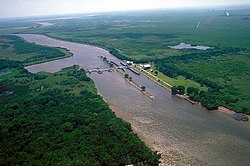| Mermentau River | |
|---|---|
 Mermentau River at the Catfish Point Control Structure, where the river flows out of Grand Lake | |
 Mermentau River | |
| Location | |
| Country | United States |
| State | Louisiana |
| Parishes | |
| Physical characteristics | |
| Source | Confluence of Bayou des Cannes and Bayou Plaquemine Brulee |
| • location | Acadia Parish |
| • coordinates | 30°12′58″N 92°34′26″W / 30.2160°N 92.5738°W |
| Mouth | Gulf of Mexico |
• location | Cameron Parish, between Calcasieu Pass and Vermilion Bay (Louisiana) |
• coordinates | 29°46′16″N 92°59′42″W / 29.7711°N 92.995°W |
| Length | 112 km (70 mi) |
The Mermentau River (French: Rivière Métave) is a 112-kilometer-long (70 mi)[1] river in southern Louisiana in the United States. It enters the Gulf of Mexico between Calcasieu Lake and Vermilion Bay on the Chenier Coastal Plain.[2]
The Mermentau River supplies freshwater for the Mermentau Basin. The Chenier Basin is located between the Mermentau Basin and the Gulf of Mexico, and is unique in that it no longer contains any true estuarine Gulf habitat, although historically the basin served as a productive estuarine nursery ground. Freshwater inflow is from the Catfish Point Control Structure. Presently, several large freshwater lakes (Grand Lake, White Lake) and confined wetlands dominate the region. These habitats are confined within the mainland and isolated from the influence of saltwater by a series of water control structures or locks.[2]
A significant percentage of the basin lands are publicly owned as Federal refuges and State wildlife management areas.[3] Pirate Jean Laffite is rumored to have sailed into the area during the 19th century, possibly stashing gold treasure.[4][5]
- ^ "National Hydrography Dataset". U.S. Geological Survey. Retrieved 2024-04-12.
- ^ a b "Mermentau River". GulfBase. Archived from the original on 2014-01-21. Retrieved 2013-07-24.
- ^ Lester, Gary D.; Sorensen, Stephen G.; Faulkner, Patricia L.; Reid, Christopher S.; Maxit, Inés E. (December 2005). "Chapter 4. Conservation Habitats & Species Assessments" (PDF). Louisiana Comprehensive Wildlife Conservation Strategy (pdf). p. 246.
- ^ Block, W. T. "Two Treasure Sites of Imperial Calcasieu Parish". Retrieved 2013-07-24.
- ^ "Heywood, Walter Scott". A Dictionary of Louisiana Biography. Louisiana Historical Association. Archived from the original on February 25, 2010. Retrieved January 30, 2011.